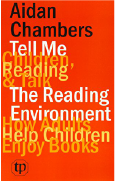 Ever been exasperated by a child taking forever to choose a book and spurning all your well meant suggestions? You may be interested in Interesting Choice, a report in the National Literacy Trust archives, which looks at how giving children choice about what they read can be an important factor in their motivation to read. So having a bit of patience while they choose may be a good thing.
Ever been exasperated by a child taking forever to choose a book and spurning all your well meant suggestions? You may be interested in Interesting Choice, a report in the National Literacy Trust archives, which looks at how giving children choice about what they read can be an important factor in their motivation to read. So having a bit of patience while they choose may be a good thing.
The report is clear that if used in a meaningful way, choice can empower children and give ownership to their reading which in turn enhances their motivation to read. However choice only works if children feel confident and have some strategies to help them choose – otherwise it can just become overwhelming. Learning to browse, assess and choose a book are skills gained through experience. While there is no simple formula that can be taught, there are strategies children can be encouraged to adopt. Drawing on a review of research about children’s reading, Interesting Choice identifies some of these:
- looking out for the clues on the book (title, blurb, front cover etc.);
- elements of the book (be guided by genre, or quick sample of the text);
- cautionary clues (looking out for things the reader knows they don’t like);
- experience desired (e.g. does the reader want to laugh or be scared?)
- recommendations (peers, adults, reviews etc.); and
- readability (e.g. sampling to check that it is not too hard to read).
While most children will work at least some of these strategies eventually, adult support and encouragement can help children develop strategies for finding books they enjoy sooner and get them hooked as readers. Aidan Chambers’ books Tell Me and The Reading Environment describe this role as an “enabling adult” positioned within “the reading circle” – a continuing sequence of selection (availability and access to books); response (book talk – formal and informal); and reading (time and space to read).
Chambers’ intended audience is teachers, who have a pivotal role. However, the crowded curriculum means that book talk with individual pupils and support in choosing books, can get crowded out. Research by the Open University and UK Literacy Association has also found that teachers have very little time to develop and keep up to date their knowledge of current children’s literature and “rely on a very limited canon of children’s authors”, so they may not be in a very strong position to make relevant recommendations. Following up on this research, the OU has now established a vibrant website and support teacher’s reading groups across the country which encourage and support teachers to expand their knowledge of children’s books, incorporate book talk into their classrooms and build ‘communities of readers’ in their schools.. There are also some other online initiatives supporting teachers reading children’s books such as @PrimarySchoolBC where teachers choose, read and discuss a different book each month via Twitter.
Alongside this is the importance of school libraries and school librarians and the role of parents. The first are an endangered breed, particularly at primary schools and continuing budget pressures on schools will only make their position more precarious. We should all be asking about how library budgets are being prioritised and safeguarded and what opportunities children are given to browse an up to date and curated selection of books and to choose books in a supported environment.
Finally, we should also be thinking about how to ensure parents have the skills to support their children’s reading choices. We have all witnessed that parent (or on occasions been that parent) that tries to steer their child away from their book of choice to something more challenging, less commercial, more what they would like their child to read, and probably knowing that the child is less likely to read the resulting choice. If choice itself is a motivation to read then helping children to learn how to choose may be more important than the choice itself.
Photo by Jon Tyson on Unsplash

